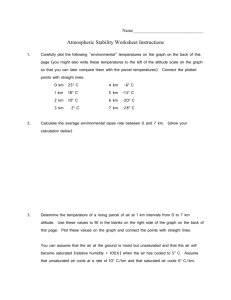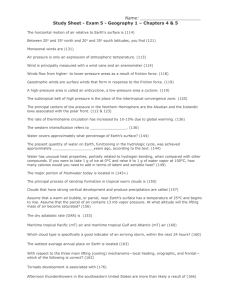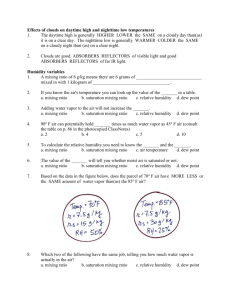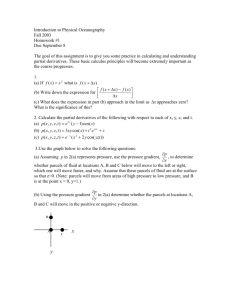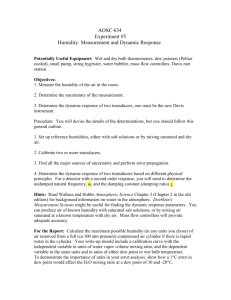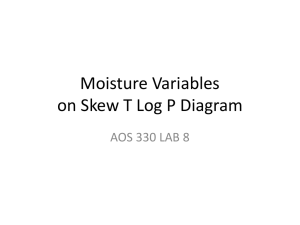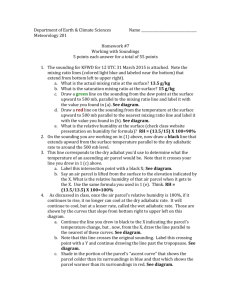Ch06TBAns
advertisement
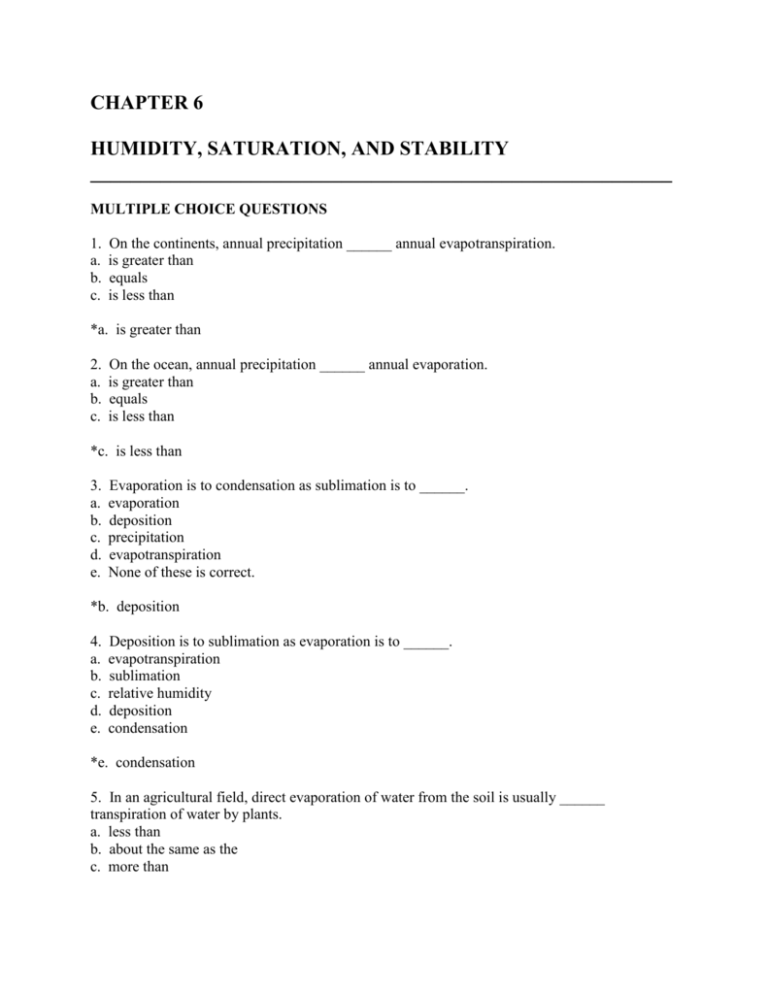
CHAPTER 6 HUMIDITY, SATURATION, AND STABILITY __________________________________________________________ MULTIPLE CHOICE QUESTIONS 1. a. b. c. On the continents, annual precipitation ______ annual evapotranspiration. is greater than equals is less than *a. is greater than 2. a. b. c. On the ocean, annual precipitation ______ annual evaporation. is greater than equals is less than *c. is less than 3. a. b. c. d. e. Evaporation is to condensation as sublimation is to ______. evaporation deposition precipitation evapotranspiration None of these is correct. *b. deposition 4. a. b. c. d. e. Deposition is to sublimation as evaporation is to ______. evapotranspiration sublimation relative humidity deposition condensation *e. condensation 5. In an agricultural field, direct evaporation of water from the soil is usually ______ transpiration of water by plants. a. less than b. about the same as the c. more than *a. less than 6. a. b. c. d. e. Direct vaporization of snow or ice without melting is known as sublimation. deposition. evaporation. evapotranspiration. transpiration. *a. sublimation. 7. The saturation vapor pressure increases with ______ air temperature. a. rising b. falling *a. rising 8. The saturation mixing ratio increases with ______ air temperature. a. rising b. falling *a. rising 9. a. b. c. As the temperature of a saturated (cloudy) air parcel falls, its relative humidity ______. increases decreases does not change *c. does not change 10. If a saturated (cloudy) air parcel is heated (say by absorption of radiation), its relative humidity ______. a. increases b. decreases c. does not change *b. decreases 11. If the temperature of an unsaturated (clear) air parcel does not change while its mixing ratio increases, the density of the parcel ______. a. increases b. decreases c. does not change *b. decreases 12. If the mixing ratio of a parcel of air is 2 grams per kilogram and its saturation mixing ratio is 6 grams per kilogram, the relative humidity is ______ percent. a. 3 b. 33.3 c. 40 d. 300 e. 333 *b. 33.3 13. If the mixing ratio of a parcel of air is 6 grams per kilogram and the relative humidity is 25 percent, the saturation mixing ratio is ______ grams per kilogram. a. 1.5 b. 12 c. 8 d. 2 e. None of these is correct. *e. None of these is correct. 14. If the air temperature is 12 oC and the vapor pressure is the same as the saturation vapor pressure, the relative humidity is a. less than 100%. b. more than 100%. c. 100%. *c. 100%. 15. Air mass advection ______ change the relative humidity. a. can b. cannot *a. can 16. On a clear and calm day, the relative humidity usually ______ between sunrise and early afternoon. a. rises b. falls c. does not change *a. rises 17. As an aircraft ascends within the troposphere, a. air pressure increases. b. the vapor pressure increases. c. saturation mixing ratio increases. d. air density increases. e. None of the above is correct. *e. None of the above is correct. 18. All of the following soundings (temperature profiles) always indicate stable atmospheric conditions with the exception of a. temperature inversion. b. isothermal conditions. c. no change in temperature with altitude. d. a drop of temperature with altitude. e. an increase in temperature with altitude. *d. a drop of temperature with altitude. 19. A temperature inversion is characterized by a(n) ______ of air temperature with altitude. a. increase b. decrease *a. increase 20. A temperature profile in which the air temperature does not change with altitude: a. lapse b. inversion c. isothermal d. None of these is correct. *c. isothermal 21. Conditional stability indicates that an air layer is a. stable for both saturated and unsaturated air parcels. b. unstable for saturated and stable for unsaturated air parcels. c. stable for saturated and unstable for unsaturated air parcels. d. unstable for both saturated and unsaturated air parcels. e. None of the above is correct. *b. unstable for saturated and stable for unsaturated air parcels. 22. Conditional stability indicates that an air layer is a. stable for both cloudy and clear air parcels. b. unstable for cloudy and stable for clear air parcels. c. stable for cloudy and unstable for clear air parcels. d. unstable for both cloudy and clear air parcels. e. None of the above is correct. *b. unstable for cloudy and stable for clear air parcels. 23. A lapse rate of ______ Celsius degrees per 1000 meters is stable for unsaturated air parcels. a. 9 b. 8 c. 2 d. All of these are correct. e. None of these is correct. *d. All of these are correct. 24. A lapse rate of ______ Celsius degrees per 1000 meters is unstable for unsaturated (clear) air parcels. a. 11 b. 8 c. 1 d. 9 e. None of these is correct. *a. 11 25. A lapse rate of ______ Celsius degrees per 1000 meters is conditionally stable. a. 12 b. 4 c. 8 d. 15 e. 2 *c. 8 26. A lapse rate of ______ Celsius degrees per 1000 meters is stable for clear air and unstable for cloudy air. a. 3 b. 7 c. 13 d. 5 e. 11 *b. 7 27. Horizontal lines on a Stüve diagram are a. isotherms. b. adiabats. c. lines of constant saturation mixing ratio. d. isobars. e. None of the above is correct. *d. isobars. 28. Normally, the stratosphere is ______. a. stable b. unstable c. conditionally stable *a. stable 29. Unstable air ______ vertical motion of air parcels. a. enhances b. suppresses c. has no effect on *a. enhances 30. Stable air ______ vertical motion of air parcels. a. enhances b. suppresses c. has no effect on *b. suppresses 31. Clouds are more likely to develop if a radiosonde sounding indicates ______ air. a. stable b. unstable *b. unstable 32. If the air temperature drops with altitude such that the actual lapse rate (sounding) is 7 Fahrenheit degrees per 1000 feet, the air layer is ______ for saturated (cloudy) air parcels and ______ for unsaturated (clear) air parcels. a. stable..................stable b. unstable...............unstable c. stable...............unstable d. unstable..............stable *d. unstable..............stable 33. Rising parcels of saturated (cloudy) air do not cool as rapidly as rising parcels of unsaturated (clear) air because a. rising parcels of saturated air do work in expanding. b. expansional cooling of saturated air is partially compensated for by release of latent heat. c. saturated air parcels are always warmer than their surroundings. d. All of the above are correct. e. None of the above is correct. *b. expansional cooling of saturated air is partially compensated for by release of latent heat. 34. A snow cover tends to ______ the overlying air. a. stabilize b. destabilize *a. stabilize 35. Cumulus clouds are more likely to form over a. snow-covered ground in winter. b. a lake surface in summer. c. vegetated land surface in summer. d. a frozen tundra in winter. e. an ice-covered lake. *c. vegetated land surface in summer. 36. As saturated (cloudy) air flows up the windward slopes of a mountain range, a. the relative humidity increases. b. the mixing ratio does not change. c. the saturation mixing ratio decreases. d. the air temperature rises. e. None of these is correct. *c. the saturation mixing ratio decreases. 37. As unsaturated (clear) air flows down the leeward slopes of a mountain range, a. the air temperature rises. b. the relative humidity decreases. c. the saturation vapor pressure increases. d. All of the above are correct. e. None of the above is correct. *d. All of the above are correct. 38. As a clear parcel of air ascends dry adiabatically, a. its relative humidity increases. b. its saturation vapor pressure decreases. c. its temperature drops. d. All of the above are correct. e. None of the above is correct. *d. All of the above are correct. 39. As an unsaturated parcel of air ascends dry adiabatically, a. b. c. d. e. its relative humidity decreases. its saturation vapor pressure increases. its temperature rises. All of the above are correct. None of the above is correct. *e. None of the above is correct. 40. A relatively warm surface tends to ______ the overlying air. a. stabilize b. destabilize *b. destabilize 41. Stable air tends to ______ convection. a. suppress b. spur *a. suppress 42. Cumulus clouds may build into thunderstorm clouds when the air temperature profile (sounding) indicates ______ conditions. a. stable b. neutral c. unstable *c. unstable 43. A rain shadow is situated downwind from the ______ slopes of a high mountain barrier. a. windward b. southern c. leeward *c. leeward 44. The relatively wet slopes of a mountain range: a. leeward side b. windward side *b. windward side 45. The greatest amount of latent heat is absorbed from the environment when a. ice changes directly to vapor. b. ice changes to the liquid phase. c. liquid changes to vapor. d. liquid changes to ice. e. frost forms. *a. ice changes directly to vapor. 46. Two equal volumes of air have the same temperature and pressure. One contains more water vapor than the other. a. Both volumes of air contain the same number of gaseous molecules. b. The more humid parcel contains more gaseous molecules than the other. c. The drier parcel contains more gaseous molecules than the other. d. None of the above is correct. *a. Both volumes of air contain the same number of gaseous molecules. 47. Two equal volumes of air at the same temperature and pressure have different amounts of water vapor in them. The air parcel with the higher relative humidity will a. weigh more than the other parcel. b. contain more molecules than the other parcel. c. contain the same number of molecules as the other parcel. d. weigh the same as the other parcel. *c. contain the same number of molecules as the other parcel. 48. The maximum pressure that water vapor molecules could exert if the air were saturated is called the a. saturation vapor pressure. b. dewpoint. c. saturation mixing ratio. d. saturation relative humidity. *a. saturation vapor pressure. 49. In winter, the precipitable water value is likely to be highest in ________. a. Miami, FL b. Denver, CO c. Milwaukee, WI *a. Miami, FL 50. Suppose the vapor pressure of the cold outside air is the same as the vapor pressure of the warm air indoors. If the door is opened and the cold air replaces some of the warm air, then the new relative humidity indoors would be a. higher than before. b. the same as before. c. lower than before. *a. higher than before.


